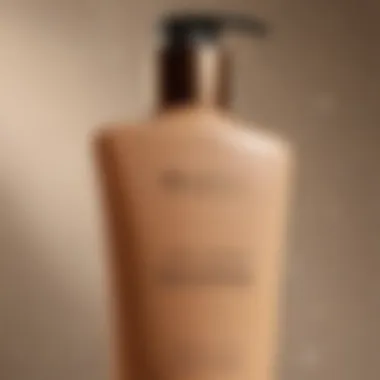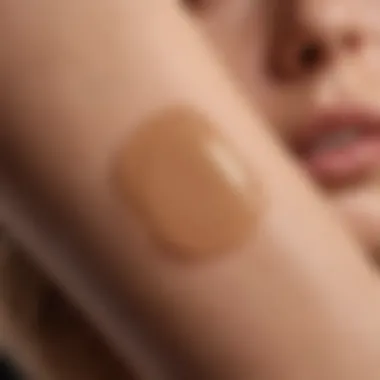Choose the Best Tan Lotion for Pale Skin


Intro
Finding the right tan lotion can feel like looking for a needle in a haystack, especially for those with pale skin. Pale tones come with their own unique set of challenges when it comes to achieving that longed-for sun-kissed glow. Navigating through the multitude of options in the market can be daunting, resembling a confusing maze that, without guidance, might leave one feeling more lost than golden.
In this guide, we’re diving deep into the intricacies of selecting the ideal tan lotion specifically tailored for lighter skin tones. It’s not just about slapping on a product and hoping for the best; understanding the formulation, ingredients, and application techniques is crucial. Moreover, considering factors like skin type and sensitivity plays a pivotal role in ensuring that the tan not only looks good but feels good too.
"The best tan isn't about the color; it’s about the skin beneath that color!"
Whether your skin is as fair as a snow-white canvas, or a subtle shade of ivory, this article endeavors to empower readers with knowledge and informed recommendations. From the significance of choosing the right product to practical tips for application, we’ll wander through the path to a radiant and even tan without compromising skin health.
Tips and How-Tos
Understanding Skincare Routines for Different Skin Types
Choosing a tan lotion means knowing your skin inside and out. If your skin tends to run as dry as a desert, you’ll prioritize moisturizing ingredients that hydrate and nourish. On the contrary, if you have oily skin, you'll want a tan lotion that absorbs quickly and won’t leave you feeling greasy.
- For Dry Skin: Look for lotions rich in ingredients like shea butter, aloe vera, and hyaluronic acid. These components can aid in keeping your skin moist while embracing that bronze charm.
- For Oily Skin: Choose formulas that are gel-based or lightweight, as these will prevent excess shine and breakouts. Tread carefully with added oils; a little goes a long way.
Application Techniques to Achieve an Even Tan
Even the best tan lotion can be rendered ineffective by improper application techniques. Here are some tried and true methods:
- Exfoliate Ahead of Time: A few days before application, gently exfoliate your skin to remove any dead cells. This creates a smooth canvas for the lotion to glide on, ultimately leading to an even color.
- Moisturize Where Needed: Pay special attention to areas prone to absorbing more color, such as elbows and knees; apply a bit of moisturizer beforehand to avoid dark patches.
- Use a Tanning Mitt: This tool helps in spreading the lotion evenly, minus the dreaded orange palms.
- Work in Sections: Apply the lotion in sections to avoid missing spots, and blend well to ensure natural-looking results.
- Building Up Color: If you’re looking for a gradual tan, it’s often better to start with a lighter color and layer it until you reach your desired shade.
These practical tips will go a long way in ensuring the product works as intended, minimizing those unfortunate mishaps such as streaks or blotches.
Recommended Products for Pale Skin
When it comes to recommendations, opting for well-highlighted options is smart. Brands such as Bondi Sands and St. Tropez are often celebrated for their tan lotions catering to lighter skin tones. Bonds Sands offers a range of products, including a self-tanning foam that is light enough for paler complexions yet builds a bronzed look effectively. St. Tropez has a gradual tanning lotion that is moisturizing and perfect for beginners.
In the journey to find the ideal tan lotion, knowledge is your best friend. Take the time to delve into the composition of tanners and apply the aforementioned insights as you embark on your quest for that sun-kissed radiance.
Understanding Pale Skin
Understanding pale skin is crucial when selecting a tan lotion that will not only provide a bronzed appearance but also suit the unique needs of lighter skin tones. Pale skin is often more sensitive and can react differently to sun exposure and cosmetic products compared to darker skin types. Thus, knowing how pale skin functions and what it requires can significantly improve your tanning experience, ensuring not only a better-looking tan but also skin health.
Characteristics of Pale Skin
Pale skin, typically characterized by a lack of melanin, varies in tones from porcelain to a fair pinkish hue. Here are some key characteristics:
- Lower Melanin Production: Pale skin constitutes less melanin compared to other skin types. This result in a higher tendency to burn instead of tan when exposed to UV rays.
- Visible Veins: Individuals with lighter skin often have more visible veins, especially in areas like the arms and legs, due to the thinner layer of melanin over blood vessels.
- Freckles and Sunspots: Fair-skinned individuals sometimes develop freckles or sunspots from sun exposure, which can affect the evenness of a tan.
- Texture and Sensitivity: Pale skin may be more prone to sensitivities or conditions such as eczema or rosacea, making it essential to choose products carefully.
Each of these traits influences how a tanning product interacts with your skin. Thus, selecting the right lotion tailored specifically for pale skin can mitigate risks and enhance results.
Common Issues Faced by Pale Skin
Pale skin doesn’t just mean lighter color; it often comes with its shares of challenges. Addressing these issues is fundamental in selecting a suitable tanning product. Here are some common problems:
- Sunburn Risk: One of the most significant concerns is the high risk of sunburn. Because pale skin burns easily, using a tanning lotion that offers some protection or is specifically formulated for sensitive skin is critical.
- Uneven Tans: Applying tanning products can lead to streaks or patches if the formulation isn't compatible with pale skin or if the application technique is improper.
- Chemical Sensitivity: Many tanning lotions contain chemicals that might irritate sensitive skin. Knowing which ingredients to avoid can help lessen adverse reactions.
- Color Match: The wrong tanning product can lead to an unrealistic shade on pale skin. Selecting the right tone that appears natural is vital to avoid an orangey or fake look.
Recognizing these issues not only prepares one for a more informed choice when selecting tanning products but also sets the foundation for a successful tanning experience.
Importance of Tanning Lotions
Choosing the right tan lotion holds significant weight, especially for those with pale skin. The choices available can seem overwhelming, but understanding the importance of these products can simplify the decision-making process and lead to a more satisfying outcome.
Tanning lotions are essential not just for aesthetics. They play a critical role in achieving a bronzed appearance without subjecting the skin to the harmful rays of the sun. For individuals with fair complexions, the sun can be notoriously unforgiving. Sunburn, premature aging, and an increased risk of skin cancer become serious considerations. Hence, a quality tanning lotion acts as a safer alternative, providing a golden glow while safeguarding skin health.
Moreover, tanning lotions are formulated with specific ingredients that nourish and hydrate the skin, which is vital for maintaining a healthy look. This is especially true for pale skin, which requires extra care and attention. A good lotion can enhance the skin’s moisture barrier, ensuring that it doesn’t dry out or flake, which might detract from any tan achieved. Besides hydrating properties, many lotions contain antioxidants and vitamins that combat skin damage.
"Using a good tanning lotion can transform the way your skin looks and feels, enhancing not just appearance but also confidence."


In addition to aesthetics and health benefits, tanning products offer a level of flexibility. They allow for control over the tanning process, making it easier to achieve the desired shade without risking damage from overexposure to UV light. This control is vital; too often, pale skin enthusiasts either retreat from all sun exposure or risk it all for a quick tan, leading to extreme consequences.
Why Opt for Tanning Products
Opting for a tanning product represents a proactive choice in skin care. For those with pale skin, tanning lotions can make a world of difference. They enable individuals to achieve a natural-looking tan without facing the risk of sunburn or other UV-related skin issues. The use of tanning products can be seen as an alternative to natural sun tanning or spray tanning, providing a middle ground.
Many lotions are designed with versatility in mind. You can apply them at home, allowing you to perfect your technique and tailor your tan to your liking. Furthermore, these lotions often come infused with fragrances - a bonus not present in some other tanning methods that can leave a chemical smell.
Tanning Lotions vs. Other Methods
When comparing tanning lotions with other methods, various factors come into play. Here’s why tanning lotions stand out:
- Convenience: Unlike professional spray tans, tanning lotions provide flexibility allowing users to tan at their own pace.
- Customization: Most tanning lotions deliver varying levels of color, which permits users to gradually build their desired shade. This aspect is particularly significant for pale skin; starting with a subtle tint leads to a more natural transition.
- Skin Care Benefits: Many lotions contain nourishing ingredients that help to maintain hydration levels, which is often overlooked in other tanning options like tanning beds or sprays. This focus on skin health is crucial for pale complexions, as they can easily become dry or irritated.
In summary, choosing the right tanning lotion is not just a mere option; it reflects a commitment to skin health while achieving a radiant, sun-kissed look safely. By understanding their importance, one can make informed decisions that marry beauty with care.
Key Ingredients to Look For
Finding the right tan lotion for pale skin isn’t just about choosing a product off the shelf. It’s crucial to consider the key ingredients that can make or break your tanning experience. Pale skin is often more sensitive and prone to reactions than darker skin tones; therefore, selecting lotions with beneficial ingredients can not only improve the tanning effects but also safeguard your skin’s health.
DHA: The Active Ingredient
DHA, or Dihydroxyacetone, is often the star player in many tanning lotions. This ingredient works by interacting with the amino acids in the outer layer of your skin, producing a golden-brown pigment. Here’s why DHA is a must-have:
- Safe and Non-Toxic: Unlike sunbathing, which exposes skin to harmful UV rays, DHA is a safe alternative to achieve that sun-kissed glow without risking skin damage.
- Variability in Formulation: Different lotions include varying percentages of DHA. For those with pale skin, a lower concentration may be advisable to avoid streaky results or an overly dark tan.
"Choosing a lotion with the right level of DHA is like picking the right paint for a canvas; too much may ruin the work!"
If you are just starting out with self-tanners, look for products with around 5% DHA. As your skin gets accustomed to it, you can move on to stronger formulations.
Natural Oils and Moisturizers
Another set of key ingredients to consider are natural oils and moisturizers that can enhance the tanning process while ensuring your skin looks hydrated and healthy. Commonly included oils are:
- Coconut Oil: Excellent for providing deep moisture, it helps keep dry skin at bay, which is crucial for an even application.
- Aloe Vera: Known for its soothing properties, aloe vera can calm any irritation and provide necessary hydration.
- Olive Oil: This ingredient is rich in antioxidants and can maintain moisture, helping extend the life of your tan.
Including these in your tan lotion can mean smoother application and a more radiant finish. Moisturizers also play a vital role in preventing patchiness, which pale skin can be prone to if hydrated poorly.
Avoiding Harmful Chemicals
When you venture into the world of tanning lotions, it’s important to keep an eye out for harmful chemicals that can aggravate sensitive skin. Here are a few ingredients to steer clear of:
- Parabens: These preservatives can cause skin irritation and trigger allergic reactions.
- Synthetic Fragrances: Though they might make the product smell good, these can be harsh on sensitive skin, often leading to breakouts or rashes.
- Alcohol: High concentrations can dry out the skin, which is especially detrimental for those with pale skin who may already struggle with moisture retention.
Taking a closer look at the ingredient list will guide you toward products that align with your values and skin type, which is essential for maintaining both the look and health of your skin.
Choosing the Best Tan Lotion
Selecting the right tan lotion can transform how pale skin looks and feels. Since lighter skin tones are more susceptible to sunburn and irritation, it’s crucial to consider a few factors before making a choice. Not every product on the shelf is tailored for pale skin; understanding your individual needs will help you pick the ideal lotion that enhances your natural complexion without causing harm.
When choosing the best tan lotion, there are a couple of key elements that should guide your decision:
- Skin sensitivity: Pale skin often reacts more strongly to various ingredients, making it vital to assess how skin may react to a certain product.
- Desired shade: Different tan lotions provide various depths of color, so understanding what look you want is essential.
- Hydration level: Moisturizing properties in the lotion can be beneficial in maintaining skin health and ensuring a smooth application.
Also, local climate conditions can impact how tan lotions develop on the skin. A product that works in a humid area may not perform the same in drier conditions.
In addition, keeping an eye out for customer feedback can provide insights into what works effectively on pale skin and what doesn’t. Reviews often detail real-life experiences, shedding light on particular products that perform well or fall flat.
Identifying Your Skin Type
Recognizing whether your skin is dry, oily, or combination can significantly influence the outcome of your tan. For instance, if you have dry skin, a lotion rich in moisturizing ingredients, such as aloe vera or coconut oil, may work wonders to keep the skin hydrated while providing a sun-kissed look. On the other hand, oily skin types might benefit from lightweight formulations that won’t clog pores, ensuring an even tan without the risk of unwanted breakouts.


Tips for Identifying Your Skin Type:
- Dry Skin: Often feels tight, may have visible flakiness.
- Oily Skin: Shiny appearance, prone to acne.
- Combination Skin: A mix of both, with dry patches and oilier sections.
Understanding your skin type helps narrow down suitable products and enhances the likelihood of achieving the desired look.
Assessing Product Claims and Reviews
When surrounded by a myriad of products claiming results that almost seem too good to be true, scrutiny is your best friend. Verifying the claims made by tan lotions—like how quickly they develop, their longevity, and the richness of color—is essential before diving into a purchase. Don’t just take marketing at face value; seek out authentic, third-party reviews and testimonials.
- Check ingredients: Transparency in ingredients can lead to a better understanding of the product. Knowledge of ingredients also helps avoid allergens or irritants that may impact sensitive skin.
- Look for before-and-after photos: They often tell a story of how a product works in real life, giving a clearer view than any ad could.
- Consumer feedback: Websites that cater to beauty reviews, like reddit.com or smaller blogs, provide honest opinions that can guide choices effectively.
"The best tan lotions have genuine endorsements from users who share both successes and mishaps. Don't miss out on the collective wisdom of fellow tanners!”
By giving a careful look at product claims and sifting through reviews, you’ll make more informed decisions that align with the needs of your unique skin, ultimately leading to a flattering and safe tanning experience.
Application Techniques for Optimal Results
Selecting a suitable tan lotion is just the first step toward achieving a sun-kissed glow. The application techniques you adopt are equally pivotal in ensuring that your tan not only looks natural but also lasts longer. Proper techniques can help mitigate common pitfalls like streaking or uneven patches which can plague those with pale skin. Emphasizing correct application helps enhance your overall tanning experience, secures a more uniform color, and boosts your confidence in flaunting your complexion.
Preparing Your Skin
Before you even think of reaching for that tan lotion, preparing your skin is of utmost importance. This process can be summarized in a few essential steps:
- Exfoliation: Giving your skin a good scrub helps remove dead skin cells. This makes the skin smooth and provides a clean canvas for the tan lotion to adhere. Consider using a gentle scrub that won’t irritate your skin. You can use homemade sugar scrubs or store-bought versions; just steer clear of ones with harsh chemicals.
- Moisturizing: Dry skin can lead to patchy tanning. After exfoliating, generously apply a good moisturizer. Focus especially on dry areas like elbows, knees, and ankles before applying the tan lotion. Ideally, choose a lightweight, water-based moisturizer to avoid any greasy residue.
- Hydration: Don’t forget to drink water. Hydration levels in your body can affect skin evenness! Drinking plenty of water ensures your skin is plump and healthy.
This preparatory phase makes a significant difference, smoothing the way for a flawless application.
Step-by-Step Application Process
Following the skin prep, it’s time to get into the nitty-gritty of applying the tan lotion. Here’s a structured approach to secure the best results:
- Choose the Right Environment: Find a well-lit, ventilated space to apply your tan lotion. Natural light helps you see any spots or areas that may need more attention.
- Put on Gloves: To avoid staining your palms, consider wearing disposable gloves. This small action can save you from prematurely orange hands.
- Start from the Feet Up: Begin the application from the feet and work your way up. This helps prevent any drips or uneven patches that can occur if you start from the upper body.
- Use Small Amounts: Squeeze a reasonable amount of lotion into your hand (or glove). Apply it using sweeping motions to evenly distribute the lotion. Less is often more; you can always add more rather than risk overdoing it right off the bat.
- Blend Blending Blending: This is where the magic happens. Focus on blending well, particularly around joints and other intricate areas. Use long, even strokes and pay special attention to those areas that tend to absorb more product.
- Face Application: For your face, use a specific facial tanning lotion if you can. Apply it with a beauty blender or a clean makeup brush, making sure the application is gentler than on the body. Your face usually requires a lighter touch for natural results.
- Drying Time: Once you’re done applying, allow the lotion to dry completely before putting on clothes. This can take anywhere from 10-30 minutes.
Tips for Even Coverage
Even coverage is essential for achieving a natural tan. Here are some insightful tips to maintain an even application:
- Use a Mirror: To avoid missed spots or awkward angles, keep a hand mirror handy. It’s a valuable tool for reaching your back or those tricky angles.
- Avoid Rush Hour: Take your time with the application. Rushing can lead to splotchy results, which, trust me, is not what anyone wants to see.
- Regular Application: Consider applying your tan lotion every few days. Keeping a consistent schedule is key to maintaining that glorious sun-kissed look.
- Instant Evaluations: After you have applied, check yourself in good light to catch any glaring mistakes. It might feel a bit odd, but a second look can save you from potential mishaps.
- Practice Makes Perfect: Don’t fret on your first try. The more you practice, the better you’ll become at assessing how much lotion is needed and where to apply it.
By following these structured techniques, you should be well on your way to achieving a radiant and lasting tan that beautifully enhances your pale skin.
Aftercare for a Lasting Tan
After achieving that coveted bronzed look, it’s paramount to maintain your golden glow through proper aftercare. Aftercare isn’t merely a suggestion; it’s a crucial element that can significantly influence how long your tan lasts and how vibrant it appears on your pale skin. By implementing the right strategies, you can prolong your sun-kissed appearance while keeping your skin healthy and thriving.
Moisturizing Techniques
Moisturizing is the cornerstone of maintaining your tan. It’s essential to keep your skin hydrated to prevent dryness and flaking, both of which could lead to uneven fading. Here are a few effective moisturizing techniques to ensure your tan stays radiant:
- Use a Lightweight Lotion: Opt for a gentle, fragrance-free lotion that won't irritate your skin. Look for ingredients like aloe vera or shea butter, which provide hydration without weighing your skin down.
- Incorporate Oils: Natural oils, such as coconut oil or argan oil, can be your skin’s best friend. They penetrate deep into the skin, locking in moisture and nourishing it. Just remember, a little goes a long way, so use sparingly to avoid a greasy feel.
- Stay Consistent: Applying moisturizer regularly—at least twice a day—helps maintain your skin's elasticity and keeps your tan looking even. Don’t wait for dryness to set in; prevention is far better than cure.
"A well-moisturized skin is like a canvas for your tan; the better the base, the more vibrant the color!"
Avoiding Products that Strip Tan
Not every product is your ally in the quest for a lasting tan. Some common cosmetic products can strip away your bronzy layer faster than you can say "glow up." Being mindful of what triggers premature fading is a must:
- Steer Clear of Alcohol-Based Products: Items like certain toners, astringents, and even some cleansers contain alcohol that can be harsh on your skin, leading to unwanted dryness and fading. Look for gentler alternatives with hydrating ingredients.
- Watch Out for Exfoliants: While exfoliating is beneficial for keeping skin fresh, over-exfoliating can slough off the top layer of skin—and your tan can fade with it. If you need to exfoliate, do so sparingly, focusing on maintaining a balance.
- Skip Heavy Duty Self-Tanners: If you dabble with additional self-tanners, choose formulas that are designed for gradual enhancement rather than intense color changes. Applying these too soon can disrupt the tan you’ve built.
By paying attention to aftercare, not only do you preserve your tan longer, but you also usher in a slew of skin benefits. A beautiful glow comes with responsibility, and investing time into your aftercare routine will pay off with a lasting, enviable tan.


Common Mistakes to Avoid
When it comes to applying tan lotion, there are pitfalls that can lead to less-than-ideal results. Missteps can result in streaks, uneven color, or even adverse reactions, especially for those with pale skin. Recognizing and understanding these common mistakes can save you time, money, and prevent skin mishaps. Improving your tanning experience advocates for a proper application and product selection tailored to your unique skin type. Here, we hone in on two major topics and how to steer clear of them, ensuring a more satisfying tan journey.
Over-Application Risks
It might seem tempting to slather on a bit more of that luxurious tan lotion, especially when your skin appears to absorb the product quickly. However, over-application poses several risks. For individuals with pale skin, excess product can lead to a dark, artificial look instead of the desired sun-kissed glow. Given that many tanning lotions contain dihydroxyacetone (DHA), which reacts with your skin’s amino acids, applying too much can alter the natural appearance you aim for.
Here are a few noticeable issues that can arise from overdoing it:
- Streaking: When too much product is applied, it can create uneven patches, leading to a splotchy appearance.
- Orange Tint: Excessive use of DHA often results in that unwanted orange shade, making it evident that you used a tanning product, rather than enjoying a natural tan.
- Irritation: Applying too thickly can overwhelm sensitive skin, potentially causing rashes or bumps.
To avoid these pitfalls, it's best to apply thin, even layers and allow the lotion ample time to dry and develop. This makes it easier to control the depth of color and lets you see how your skin responds. If you're unsure, start with less and build up gradually—better safe than sorry!
Neglecting Skin Sensitivity
Ignoring skin sensitivity is another major mistake many make when selecting and applying tanning lotions. Pale skin often comes with special considerations, and neglecting to address these can yield disappointing results or even harm.
Every person's skin reacts differently, but here are a few considerations:
- Allergies or Reactions: Before using a new tan lotion, always conduct a patch test to see how your skin responds. Ingredients can sometimes cause adverse reactions, particularly with sensitive skin.
- Condition of Your Skin: Dryness, eczema, or other conditions can exacerbate unwanted reactions to tanning products. It's good to consider if your skin is prepped properly. Regular exfoliation and moisturizing can help create an ideal base, but be careful not to over-exfoliate as that might lead to more sensitivity.
- Sun Exposure: Long exposure to the sun prior to application can also irritate your skin, making it harder to achieve an even tan. Keeping an eye on your skin’s current state ensures you're not working against it.
By being mindful of how your skin interacts with tanning products, you can make informed choices that enhance your overall experience—leading to a captivating and radiant bronzed look.
"The right tan lotion does not just enhance your glow; it should respect and react favorably with your skin type."
To summarize, avoiding over-application and being attentive to skin sensitivity are crucial steps in the quest for the perfect tan. Taking the time to understand these elements can make all the difference in achieving a natural-looking, beautiful tan.
Recommended Tan Lotions for Pale Skin
Choosing the right tan lotion is a significant step for those with pale skin. It’s not just about achieving a bronzed look; it’s about finding the right product that caters to specific needs. Pale skin can be particularly sensitive, often reacting to chemicals or strong dyes present in some tanning products. Hence, selecting a lotion that can enhance your natural tone without going overboard is crucial.
Top Drugstore Options
When it comes to tan lotions that won’t break the bank, drugstore options excel in both accessibility and effectiveness. These are generally formulated to be user-friendly, catering to a broad audience but especially beneficial for those with lighter skin tones.
- Jergens Natural Glow: This gradual tanner employs a blend of moisturizers, enhancing pale skin while allowing you to control the depth of color. Its oil-free formula makes it a breeze for daily use.
- Palmer’s Cocoa Butter Formula: With natural ingredients like cocoa butter and vitamin E, this lotion not only adds color but hydrates the skin. It’s like a one-two punch, nourishing the skin while creating that subtle glow.
- L’Oreal Paris Sublime Bronze: A staple in many bathroom cabinets, this lotion is designed to provide a streak-free application. Great for those new to self-tanning, it’s lightweight and absorbed quickly.
High-End Choices for Luxury Tanning
If you’re willing to splurge a bit, there are high-end tanning lotions that incorporate superior ingredients and offer a more refined experience. These products often provide a richer, longer-lasting tan and come with added skincare benefits.
- St. Tropez Classic Bronzing Lotion: Recognized in the beauty industry, this lotion delivers a natural-looking tan while infusing skin with moisture. The olive undertones work wonders for pale skin, reducing any orange tint.
- Vita Liberata Phenomenal Tan: This one’s top-notch in providing a deep, golden glow that lasts longer than your typical lotion. Infused with skincare benefits, it’s an ideal choice for those who prioritize both health and looks.
- TAN-LUXE THE BUTTER: This lotion boasts a dual action as both a tanner and a daily moisturizer. It pulls in natural ingredients which work in harmony with your skin, offering a beautiful tan without sacrificing hydration.
"The right tan lotion is not just a beauty product; it's an investment in self-confidence for individuals with pale skin."
Whether you are going for an everyday glow or preparing for a special event, knowing your options allows for more informed decisions. Take into consideration ingredients, application ease, and user reviews to pinpoint the lotion that will complement your skin tone best.
Ending
Selecting the right tan lotion for pale skin is not merely about color; it’s an integral part of self-care that reflects one’s understanding and acceptance of their unique skin tone. It’s essential to appreciate that pale skin, while it may have its limitations regarding tanning, can also be a canvas for showcasing beauty through thoughtfully chosen products. With a vast array of tan lotions available, individuals can find formulations that cater specifically to their skin needs, effectively reducing risks such as streaks or orange hues that often arise from improper choices.
Embracing Your Unique Skin Tone
In a world that often promotes bronzed perfection, it is vital to embrace your unique skin tone. Pale skin has a subtle charm, often characterized by delicate undertones that can shine with the right tan products. Acknowledging that one’s skin is not a deficiency but rather a distinct attribute is critical. Tanning lotions designed for pale skin can assist in enhancing this natural beauty without overwhelming it.
- Understand Your Undertones: Determine whether your undertones are cool, warm, or neutral. This can guide you in selecting a lotion that enhances rather than clashes with your complexion.
- Gradual Tanning Lotions: These are often more forgiving for paler skin because they allow for incremental coloration and minimize chances of over-application.
Ultimately, embracing your skin tone entails recognizing that beauty does not conform to a singular standard, but varies pleasantly from one individual to another.
Final Thoughts on Tan Lotions
Navigating the realm of tan lotions can seem like wandering through a maze, especially when catering to pale skin. However, informed choices can lead to the radiant glow many desire. Key aspects to consider include:
- Ingredients: Look for products rich in natural oils and avoid harsh chemicals that can irritate sensitive skin.
- Application Techniques: Proper application is just as vital as the product itself, ensuring an even distribution that enhances the tan.
- Regular Maintenance: An ongoing skincare regimen helps sustain the tan, contributing to an overall healthy skin appearance.
"With a little patience and the right products, pale skin can achieve a beautiful, sun-kissed glow."







